Abstract
Dopexamine is an agonist at peripheral dopamine receptors and at beta 2-adrenoceptors. Dopexamine has approximately one-third the potency of dopamine in stimulating the vascular DA1-receptor in the dog, resulting in a fall in renal vascular resistance of 20% at 2.3 X 10(-8) mol kg-1 (i.a.). Prejunctional DA2-receptors are also stimulated by dopexamine, resulting in a reduction of neurogenic vasoconstriction in the rabbit isolated ear artery (IC50 of 1.15 X 10(-6)M) and of neurogenic tachycardia in the cat (ID50 of 5.4 X 10(-8) mol kg-1, i.v.), with a potency six and four times less respectively than that of dopamine. By contrast, dopexamine is approximately 60 times more potent than dopamine as an agonist at the beta 2-adrenoceptor of the guinea-pig isolated tracheal chain, with an EC50 of 1.5 X 10(-6)M. Both dopexamine and dopamine are weak agonists at the guinea-pig atrial beta 1-adrenoceptor over the concentration range 10(-7) to 10(-4) M, but dopexamine has an intrinsic activity of only 0.16 relative to dopamine. Dopexamine does not stimulate postjunctional alpha 1- or alpha 2-adrenoceptors in the canine isolated saphenous vein, whereas dopamine is an agonist, approximately 120 times less potent than noradrenaline. Unlike dopamine and salbutamol, dopexamine does not cause arrhythmias in the guinea-pig isolated perfused heart at doses of up to 10(-5) mol, which is a thousand times the minimum cardiostimulant dose. The combination of agonist properties at peripheral dopamine receptors and at beta 2-adrenoceptors, with little or no activity at alpha- and beta 1-adrenoceptors gives dopexamine a novel pharmacological profile. This may confer advantages over dopamine in the treatment of acute heart failure.
Full text
PDF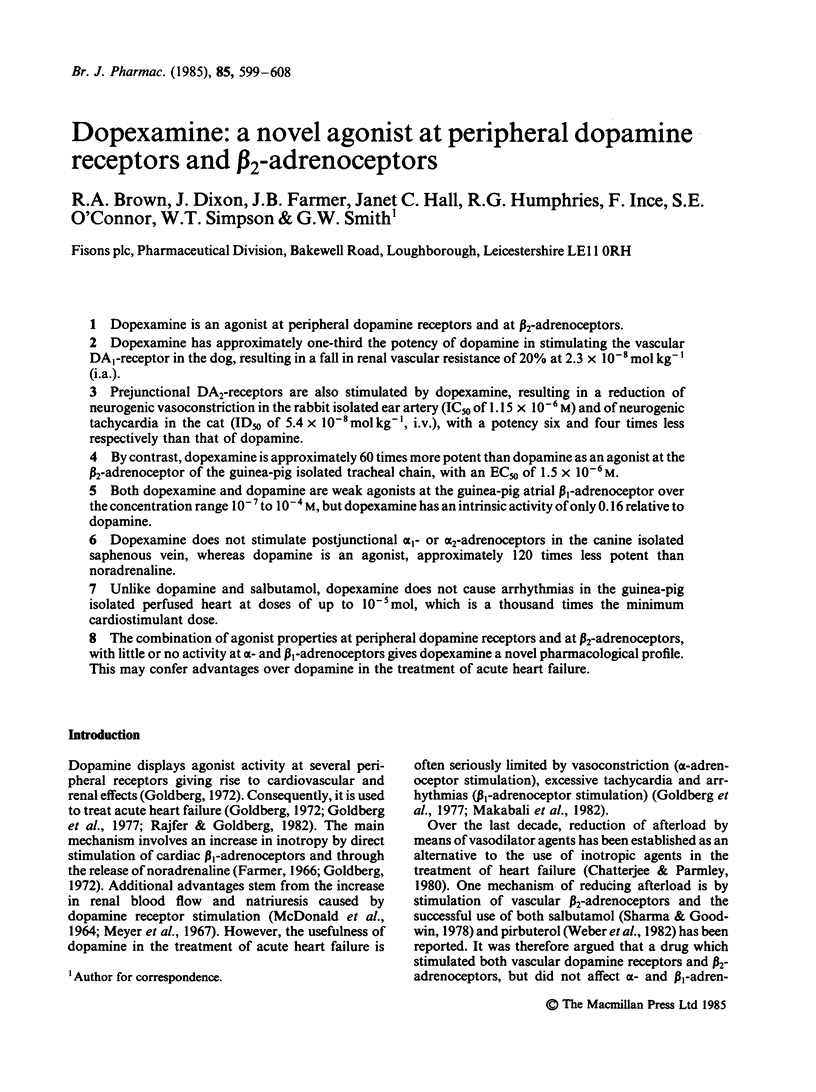

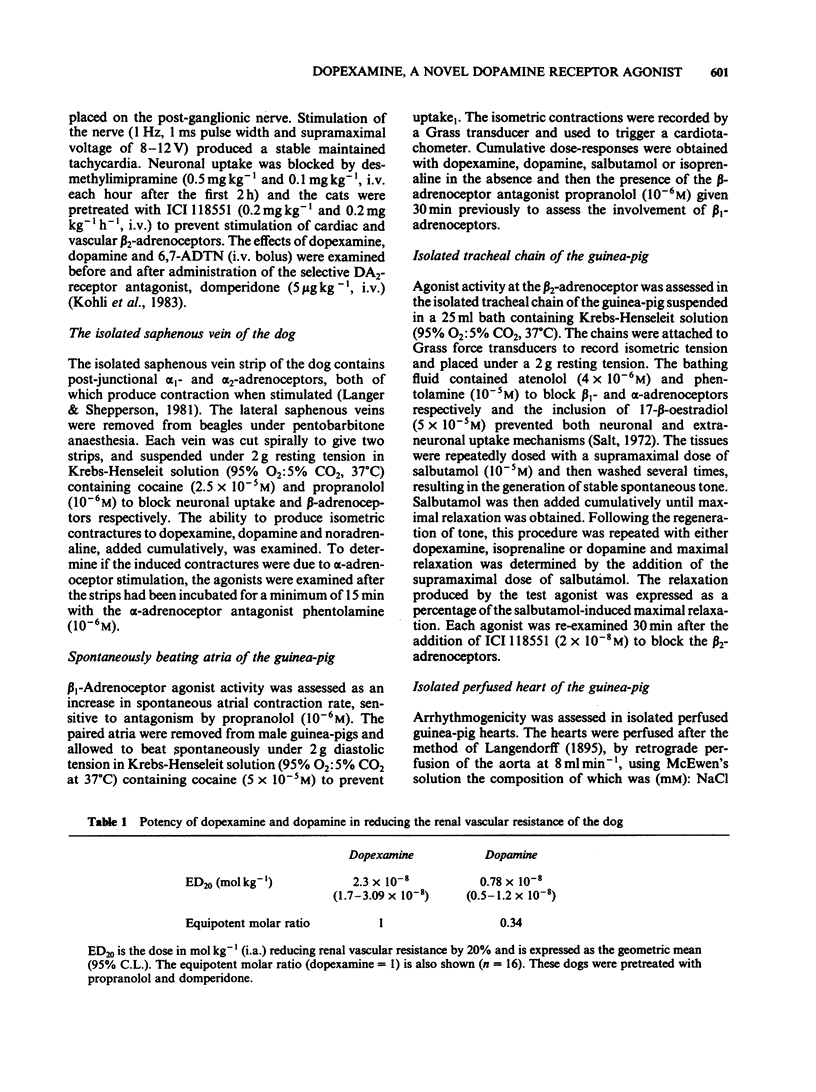
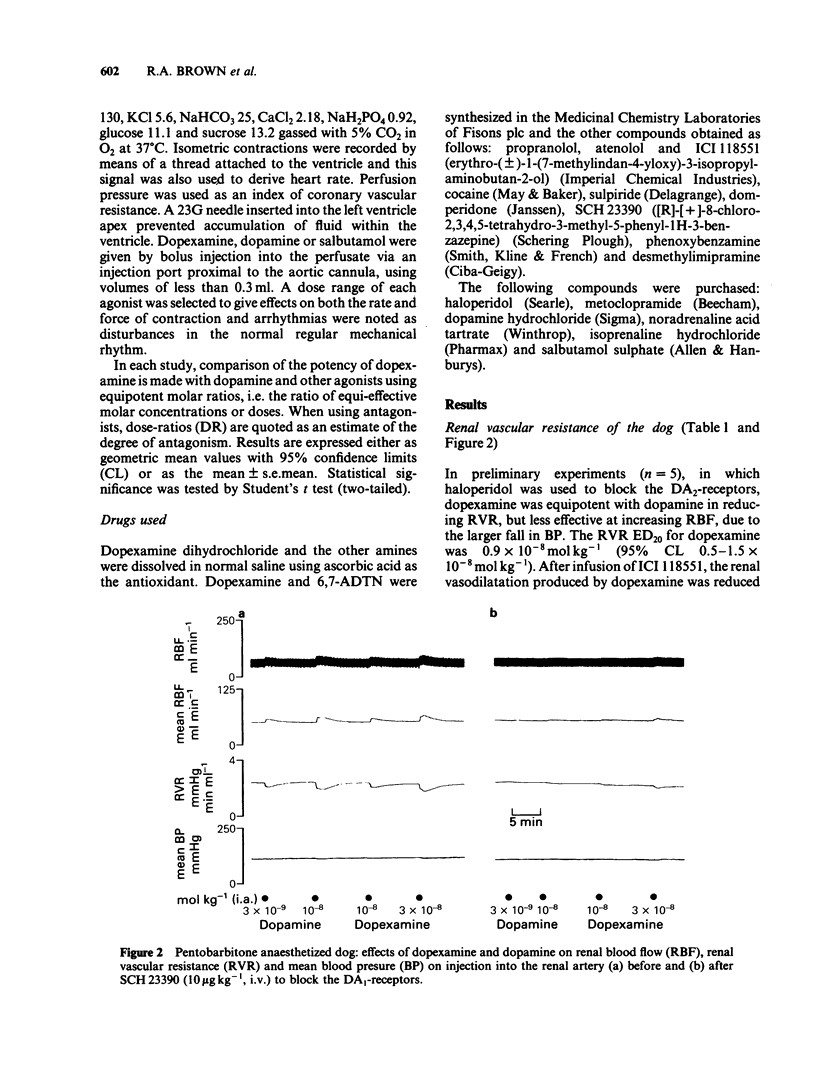
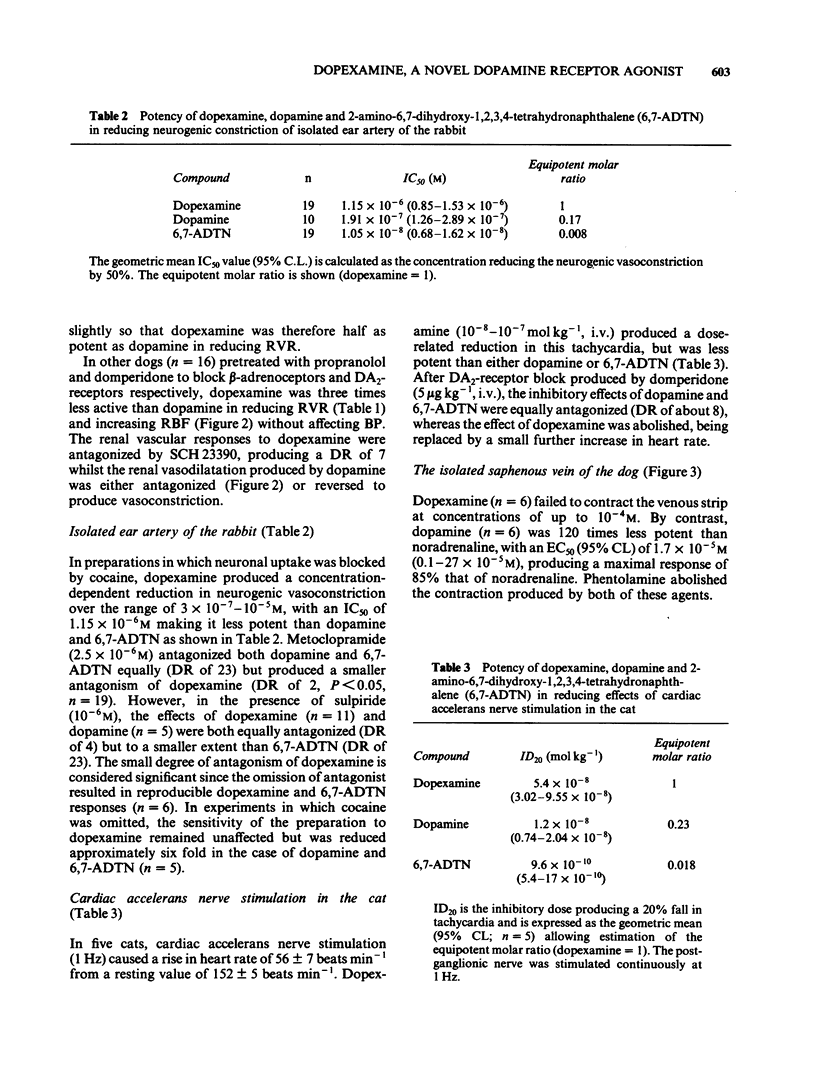
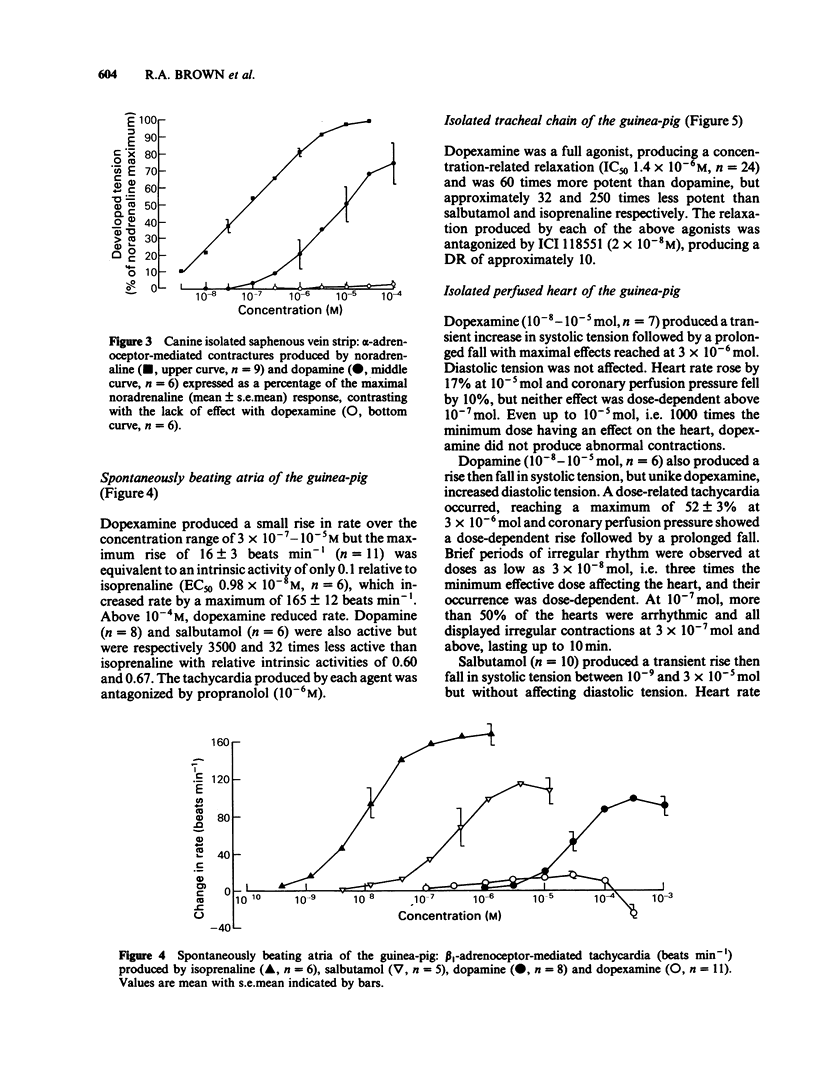

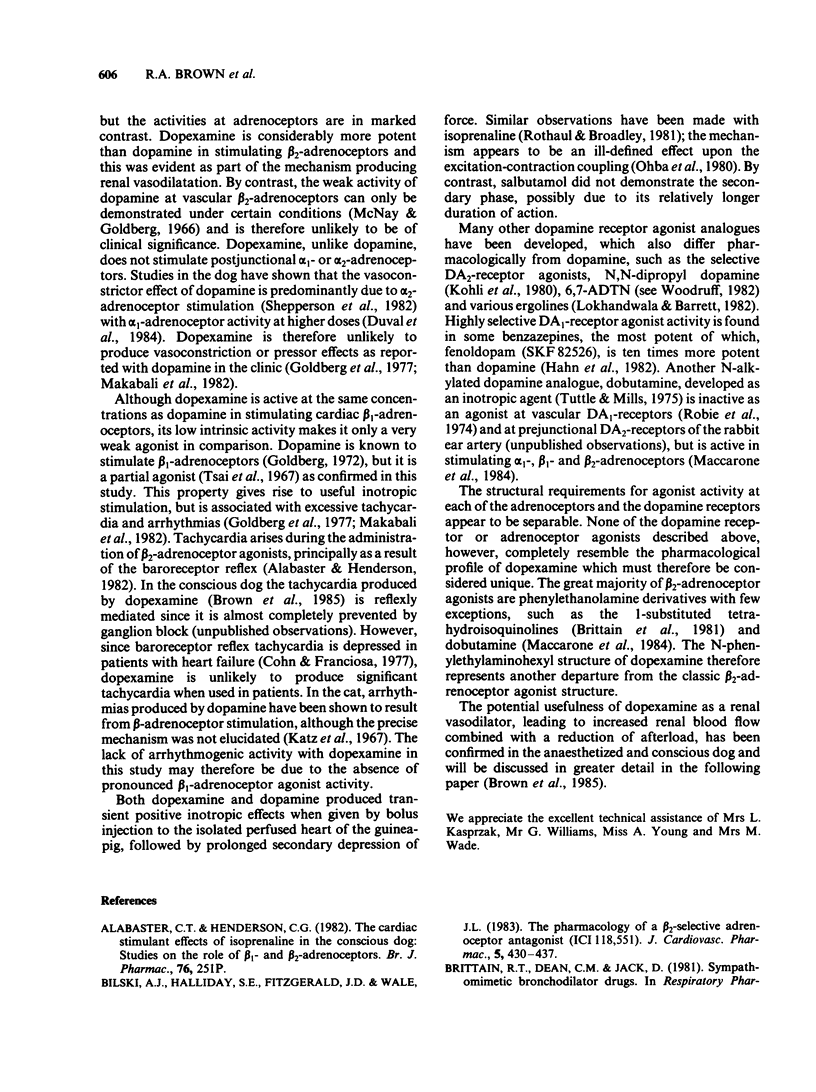
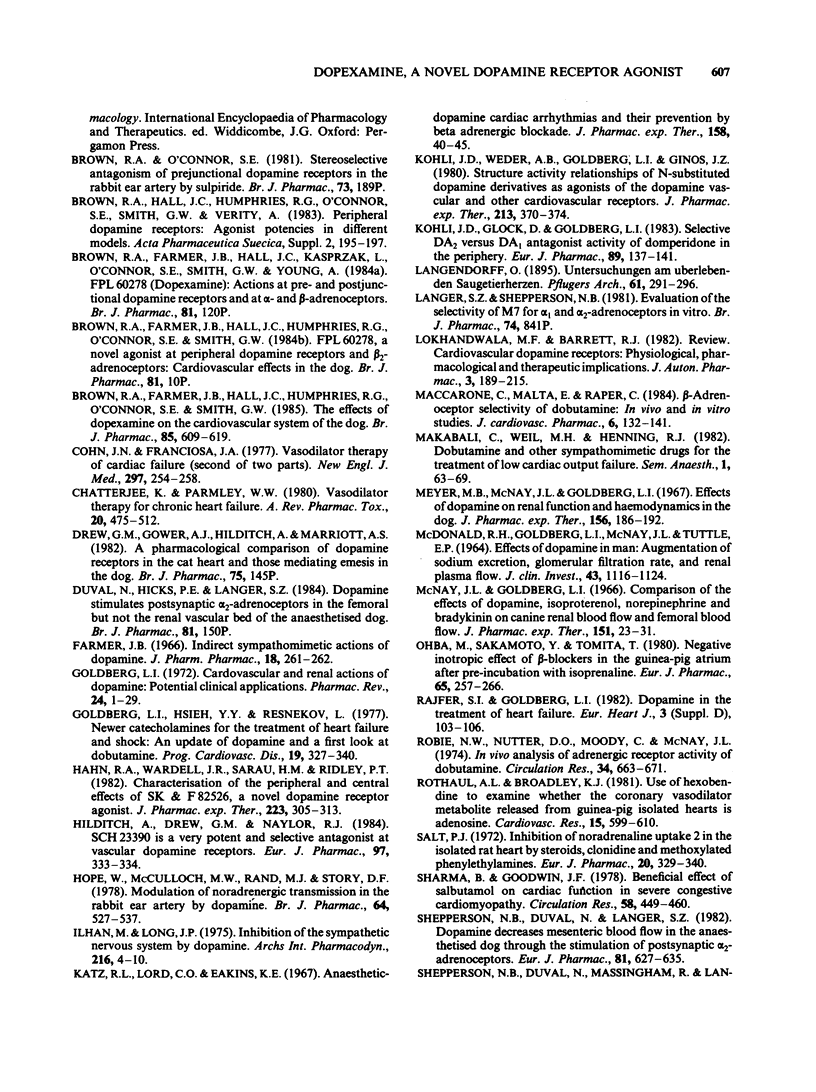

Selected References
These references are in PubMed. This may not be the complete list of references from this article.
- Bilski A. J., Halliday S. E., Fitzgerald J. D., Wale J. L. The pharmacology of a beta 2-selective adrenoceptor antagonist (ICI 118,551). J Cardiovasc Pharmacol. 1983 May-Jun;5(3):430–437. doi: 10.1097/00005344-198305000-00013. [DOI] [PubMed] [Google Scholar]
- Brown R. A., Farmer J. B., Hall J. C., Humphries R. G., O'Connor S. E., Smith G. W. The effects of dopexamine on the cardiovascular system of the dog. Br J Pharmacol. 1985 Jul;85(3):609–619. doi: 10.1111/j.1476-5381.1985.tb10555.x. [DOI] [PMC free article] [PubMed] [Google Scholar]
- Chatterjee K., Parmley W. W. Vasodilator therapy for chronic heart failure. Annu Rev Pharmacol Toxicol. 1980;20:475–512. doi: 10.1146/annurev.pa.20.040180.002355. [DOI] [PubMed] [Google Scholar]
- Cohn J. N., Franciosa J. A. Vasodilator therapy of cardiac failure (second of two parts). N Engl J Med. 1977 Aug 4;297(5):254–258. doi: 10.1056/NEJM197708042970506. [DOI] [PubMed] [Google Scholar]
- Dhawan B. N., Shukla R., Srimal R. C. Analysis of histamine receptors in the central thermoregulatory mechanism of Mastomys natalensis. Br J Pharmacol. 1982 Jan;75(1):145–149. doi: 10.1111/j.1476-5381.1982.tb08767.x. [DOI] [PMC free article] [PubMed] [Google Scholar]
- Farmer J. B. Indirect sympathomimetic actions of dopamine. J Pharm Pharmacol. 1966 Apr;18(4):261–262. doi: 10.1111/j.2042-7158.1966.tb07866.x. [DOI] [PubMed] [Google Scholar]
- Goldberg L. I. Cardiovascular and renal actions of dopamine: potential clinical applications. Pharmacol Rev. 1972 Mar;24(1):1–29. [PubMed] [Google Scholar]
- Goldberg L. I., Hsieh Y. Y., Resnekov L. Newer catecholamines for treatment of heart failure and shock: an update on dopamine and a first look at dobutamine. Prog Cardiovasc Dis. 1977 Jan-Feb;19(4):327–340. doi: 10.1016/0033-0620(77)90007-x. [DOI] [PubMed] [Google Scholar]
- Hahn R. A., Wardell J. R., Jr, Sarau H. M., Ridley P. T. Characterization of the peripheral and central effects of SK&F 82526, a novel dopamine receptor agonist. J Pharmacol Exp Ther. 1982 Nov;223(2):305–313. [PubMed] [Google Scholar]
- Hilditch A., Drew G. M., Naylor R. J. SCH 23390 is a very potent and selective antagonist at vascular dopamine receptors. Eur J Pharmacol. 1984 Jan 27;97(3-4):333–334. doi: 10.1016/0014-2999(84)90471-0. [DOI] [PubMed] [Google Scholar]
- Hope W., McCulloch M. W., Rand M. J., Story D. F. Modulation of noradrenergic transmission in the rabbit ear artery by dopamine. Br J Pharmacol. 1978 Dec;64(4):527–537. doi: 10.1111/j.1476-5381.1978.tb17314.x. [DOI] [PMC free article] [PubMed] [Google Scholar]
- Ilhan M., Long J. P. Inhibition of the sympathetic nervous system by dopamine. Arch Int Pharmacodyn Ther. 1975 Jul;216(1):4–10. [PubMed] [Google Scholar]
- Katz R. L., Lord C. O., Eakins K. E. Anesthetic-dopamine cardiac arrhythmias and their prevention by beta adrenergic blockade. J Pharmacol Exp Ther. 1967 Oct;158(1):40–45. [PubMed] [Google Scholar]
- Kohli J. D., Glock D., Goldberg L. I. Selective DA2 versus DA1 antagonist activity of domperidone in the periphery. Eur J Pharmacol. 1983 Apr 22;89(1-2):137–141. doi: 10.1016/0014-2999(83)90618-0. [DOI] [PubMed] [Google Scholar]
- Kohli J. D., Weder A. B., Goldberg L. I., Ginos J. Z. Structure activity relationships of N-substituted dopamine derivatives as agonists of the dopamine vascular and other cardiovascular receptors. J Pharmacol Exp Ther. 1980 May;213(2):370–374. [PubMed] [Google Scholar]
- Lokhandwala M. F., Barrett R. J. Cardiovascular dopamine receptors: physiological, pharmacological and therapeutic implications. J Auton Pharmacol. 1982 Sep;2(3):189–215. doi: 10.1111/j.1474-8673.1982.tb00489.x. [DOI] [PubMed] [Google Scholar]
- MCDONALD R. H., Jr, GOLDBERG L. I., MCNAY J. L., TUTTLE E. P., Jr EFFECT OF DOPAMINE IN MAN: AUGMENTATION OF SODIUM EXCRETION, GLOMERULAR FILTRATION RATE, AND RENAL PLASMA FLOW. J Clin Invest. 1964 Jun;43:1116–1124. doi: 10.1172/JCI104996. [DOI] [PMC free article] [PubMed] [Google Scholar]
- Maccarrone C., Malta E., Raper C. Beta-adrenoceptor selectivity of dobutamine: in vivo and in vitro studies. J Cardiovasc Pharmacol. 1984 Jan-Feb;6(1):132–141. [PubMed] [Google Scholar]
- McNay J. L., Goldberg L. I. Comparison of the effects of dopamine, isoproterenol, norepinephrine and bradykinin on canine renal and femoral blood flow. J Pharmacol Exp Ther. 1966 Jan;151(1):23–31. [PubMed] [Google Scholar]
- Meyer M. B., McNay J. L., Goldberg L. I. Effects of dopamine on renal function and hemodynamics in the dog. J Pharmacol Exp Ther. 1967 Apr;156(1):186–192. [PubMed] [Google Scholar]
- Ohba M., Sakamoto Y., Tomita T. Negative inotropic effect of beta-blockers in the guinea-pig atrium after preincubation with isoprenaline. Eur J Pharmacol. 1980 Jul 25;65(2-3):257–266. doi: 10.1016/0014-2999(80)90399-4. [DOI] [PubMed] [Google Scholar]
- Rajfer S. I., Goldberg L. I. Dopamine in the treatment of heart failure. Eur Heart J. 1982 Dec;3 (Suppl 500):103–106. [PubMed] [Google Scholar]
- Robie N. W., Nutter D. O., Moody C., McNay J. L. In vivo analysis of adrenergic receptor activity of dobutamine. Circ Res. 1974 May;34(5):663–671. doi: 10.1161/01.res.34.5.663. [DOI] [PubMed] [Google Scholar]
- Rothaul A. L., Broadley K. J. Use of hexobendine to examine whether the coronary vasodilator metabolite released from guinea-pig isolated hearts is adenosine. Cardiovasc Res. 1981 Oct;15(10):599–610. doi: 10.1093/cvr/15.10.599. [DOI] [PubMed] [Google Scholar]
- Salt P. J. Inhibition of noradrenaline uptake 2 in the isolated rat heart by steroids, clonidine and methoxylated phenylethylamines. Eur J Pharmacol. 1972 Dec;20(3):329–340. doi: 10.1016/0014-2999(72)90194-x. [DOI] [PubMed] [Google Scholar]
- Sharma B., Goodwin J. F. Beneficial effect of salbutamol on cardiac function in severe congestive cardiomyopathy. Effect on systolic and diastolic function of the left ventricle. Circulation. 1978 Sep;58(3 Pt 1):449–460. doi: 10.1161/01.cir.58.3.449. [DOI] [PubMed] [Google Scholar]
- Shepperson N. B., Duval N., Langer S. Z. Dopamine decreases mesenteric blood flow in the anaesthetised dog through the stimulation of postsynaptic alpha 2-adrenoceptors. Eur J Pharmacol. 1982 Jul 30;81(4):627–635. doi: 10.1016/0014-2999(82)90352-1. [DOI] [PubMed] [Google Scholar]
- Shepperson N. B., Duval N., Massingham R., Langer S. Z. Differential blocking effects of several dopamine receptor antagonists for peripheral pre- and postsynaptic dopamine receptors in the anesthetized dog. J Pharmacol Exp Ther. 1982 Jun;221(3):753–761. [PubMed] [Google Scholar]
- Tsai T. H., Langer S. Z., Trendelenburg U. Effects of dopamine and alpha-methyl-dopamine on smooth muscle and on the cardiac pacemaker. J Pharmacol Exp Ther. 1967 May;156(2):310–324. [PubMed] [Google Scholar]
- Tuttle R. R., Mills J. Dobutamine: development of a new catecholamine to selectively increase cardiac contractility. Circ Res. 1975 Jan;36(1):185–196. doi: 10.1161/01.res.36.1.185. [DOI] [PubMed] [Google Scholar]
- Weber K. T., Andrews V., Janicki J. S., Likoff M., Reichek N. Pirbuterol, an oral beta-adrenergic receptor agonist, in the treatment of chronic cardiac failure. Circulation. 1982 Dec;66(6):1262–1267. doi: 10.1161/01.cir.66.6.1262. [DOI] [PubMed] [Google Scholar]


